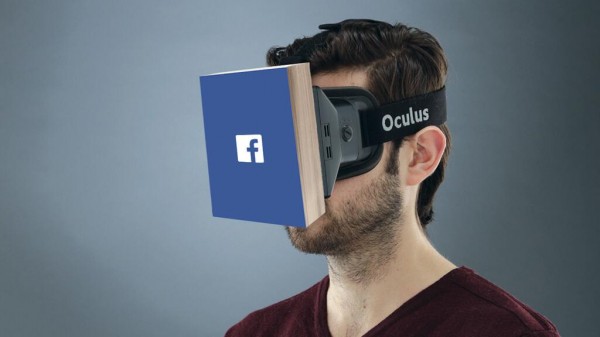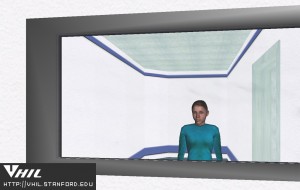
We previously reported on virtual reality hardware company Oculus VR before its $2 billion acquisition by Facebook was announced on March 25. With the Federal Trade Commission approving the acquisition in late April and the impending deal closure, many people are wondering why the biggest social media website acquired a virtual reality headset developer and what this means for their social media experience.
Oculus has the chance to create the most social platform ever, and change the way we work, play and communicate.” – Facebook founder and CEO Mark Zuckerberg in an official press release, 3.25.2014
On the surface, the Oculus acquisition is more confusing than Facebook’s other recent acquisition of mobile message application WhatsApp. Oculus VR positioned itself in the marketplace as an innovative 3D gaming headset developer and Facebook was hardly known as a hub of gaming activity outside of numerous casual games like FarmVille and Mafia Wars, games that any layperson would know requires no fancy immersive VR headset. Instead, Facebook is looking beyond gaming and sees virtual reality technology as a compelling candidate for the next transformative social and communications platform. This technology has broad potential applications in many other industry verticals, including media and entertainment, and education.
Virtual reality transforms relationships that tend to be abstract to become visceral. Our research has shown that making this cause and effect relationship perceptual, as opposed to theoretical, changes consumer and other behaviors more than other interventions.” – Stanford University’s Virtual Human Interaction Lab director Jeremy Bailenson
Stanford University’s Virtual Human Interaction Lab has already been working a number of thought-provoking experiments using digital representations known as “avatars” in virtual realities to better understand human interactions within the digital realm.
Millions of people use these representations of themselves to interact with other avatars in a variety of digital environments such as online communities like Second Life or gaming platforms like the Nintendo Wii (“Mii”) and Microsoft Xbox (“LIVE Avatar”). There are many unique advantages to using avatars in communication. They require much less bandwidth because avatar technology does not continuously capture and send movement like traditional videoconferencing.
Avatars can appear as realistic or unrealistic as a user desires. These digital representations can be liberating for many users as real-life factors such as age, weight, and gender do not matter. Filtered or altered representations could possibly do things others cannot do in real life, which also adds a layer of safety and privacy. What is also advantageous is that avatars also have the remarkable ability to influence others and can even alter social behaviors and work performance.
Stanford University VHIL student Nick Yee studied the possibilities of social influence resulting from the chameleon effect, the tendency for mimickers to gain social influence, in virtual reality-mediated communication.1 Avatars are better suited to mimicry than humans as it require a huge amount of effort and can appear too obvious, which would have the opposite effect of social influence. In Yee’s study, the avatars that mimicked the human’s behavior were considered more persuasive and likable than an avatar that utilized recorded head movements.1 The mimicking avatars were also perceived as smarter and more trustworthy than their non-mimicking digital counterparts.

Yee expanded on his virtual reality research by studying what he called the Proteus effect, named after the shape-shifting Greek God. The phenomenon centers around how the subjects made inferences of expected dispositions and attitudes based their avatar’s appearance and then conformed to the expected attitudes and behavior.2 Changing something as simple as height and weight, or complex as perceived attractiveness, resulted in huge behavioral changes: the “attractive” avatars were more friendly to equally attractive avatars; the taller avatars encouraged subjects to behave more confidently. Yee discovered that these changes in avatar appearance not only resulted in behavioral changes in avatar-based online but also face-to-face interactions appearance changes as well.2
Avatars play a large part in communication with millions of people using avatars each week. Our relationship with technology already influences how we see the world. Now we are taking a step further into a new future of virtual reality, a future that communication theorist Marshall Mcluhan deftly foretold decades ago: “All technology is communication, an extension of ourselves that allows us to reach further through time and/or space.”3 Avatars and virtual reality truly do allow us to extend our bodies through these digital representations and send them through virtual space and time. This technology allows us to communicate in ways we might have never fully imagined.
Speaking about technology in general, Mcluhan was far ahead of his time. Applying his ideas to this acquisition of Oculus VR by Facebook, this deal is absolutely a case of new technologies (virtual reality) used to mirror the human body (avatars) but extend the capabilities beyond this form (i.e. chameleon and Proteus effects). Mcluhan’s technological determinist view sees the medium as the message. What matters is the technology or technological environment in which communication and culture now takes place; the medium of Facebook is the message.
More than one billion people use social media, Facebook specifically. According to IDC Research’s “Always Connected” research report, people check Facebook an average of 14 times per day during the week and that number rises to an average of 18 times per day during the weekend3. So many people are already online and essentially “living” on Facebook; now Facebook is making a $2 billion bet that people that want more “reality” in their surrogate digital world, one so immersive and unique that the online experience melds into the real world.
Sources:
- Bailenson, J.N. & Yee, N. (2005). Digital Chameleons: Automatic assimilation of nonverbal gestures in immersive virtual environments. Psychological Science, 16, 814-819.
- Yee, N. & Bailenson, J.N. (2007). The Proteus Effect: The Effect of Transformed Self-Representation on Behavior. Human Communication Research, 33, 271-290.
- McLuhan,Marshall. Understanding Media: The Extensions of Man, McGraw-Hill, New York, NY, 1964
- Always Connected How Smartphones And Social Keep Us Engaged . (2013, March 27).Facebook News: IDC Study: Mobile and Social = Connectiveness. Retrieved May 7, 2014, from https://fb-public.app.box.com/s/3iq5x6uwnqtq7ki4q8wk

Leave a Reply
You must be logged in to post a comment.